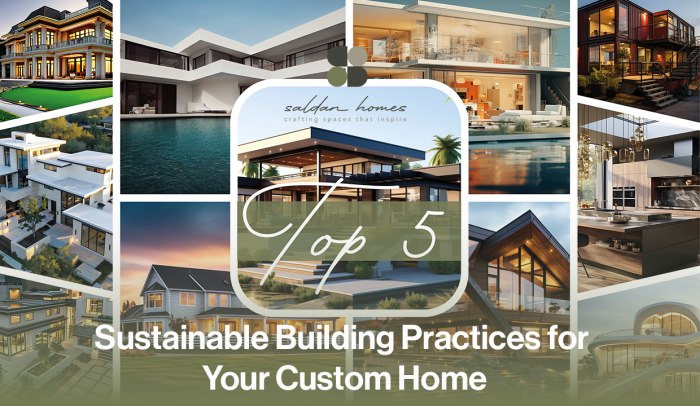With Sustainability Focus in Fine Homebuilding at the forefront, this paragraph opens a window to an amazing start and intrigue, inviting readers to embark on a storytelling journey filled with unexpected twists and insights.
As we delve into the realm of fine homebuilding, the importance of sustainability becomes evident in shaping a more eco-friendly and cost-effective future for homeowners.
Importance of Sustainability in Fine Homebuilding
Integrating sustainability practices in fine homebuilding is crucial for reducing the environmental impact of construction projects and ensuring long-term benefits for homeowners.
Sustainability not only helps in conserving natural resources but also contributes to cost savings for homeowners in the long run. By using energy-efficient materials and techniques, homeowners can lower their utility bills and reduce maintenance costs over time.
Examples of Sustainable Materials and Techniques
- Utilizing recycled or reclaimed materials such as reclaimed wood or recycled glass for construction
- Installing energy-efficient appliances and fixtures to reduce energy consumption
- Incorporating passive solar design to optimize natural light and heat in the home
- Implementing rainwater harvesting systems to reduce water usage and dependency on external sources
Sustainable Design Principles in Fine Homebuilding

In fine homebuilding, sustainable design principles play a crucial role in creating environmentally friendly and energy-efficient homes that prioritize long-term sustainability.
Comparison of Traditional Home Design and Sustainable Design
When comparing traditional home design with sustainable design practices, it becomes evident that sustainable design focuses on reducing the environmental impact of the construction process and the operation of the home. Traditional homes often prioritize aesthetics and immediate costs without considering long-term sustainability factors.
- Sustainable design incorporates energy-efficient materials and techniques to minimize energy consumption and reduce carbon footprint.
- Traditional home design may overlook energy-efficient features, resulting in higher energy bills and increased environmental impact.
- Sustainable design aims to use renewable resources and recycled materials to promote resource efficiency and reduce waste.
Incorporating Natural Light and Ventilation for Sustainability
Utilizing natural light and ventilation in home design can significantly enhance sustainability by reducing the need for artificial lighting and mechanical cooling systems.
Maximizing natural light through strategic window placement and skylights can reduce energy consumption and create a healthier indoor environment.
- Proper ventilation design can help regulate indoor temperature, improve indoor air quality, and reduce the reliance on air conditioning systems.
- Integrating operable windows and passive ventilation techniques can enhance cross-ventilation and natural cooling, decreasing the need for mechanical ventilation.
Energy Efficiency in Fine Homebuilding
Energy efficiency plays a crucial role in sustainable homebuilding, helping to reduce energy consumption and minimize environmental impact.
Role of Energy-Efficient Systems and Appliances
Energy-efficient systems and appliances are designed to consume less energy while still providing the necessary functionality. These components help lower energy bills, reduce greenhouse gas emissions, and decrease the overall carbon footprint of a home
Benefits of Using Renewable Energy Sources
Utilizing renewable energy sources like solar panels in fine homebuilding can significantly reduce reliance on traditional energy sources. Solar panels harness the power of the sun to generate electricity, offering a clean and sustainable energy solution for homeowners. In addition to reducing utility costs, solar panels can also increase the value of a home and contribute to a greener environment.
Importance of Proper Insulation and Sealing
Proper insulation and sealing are essential elements of energy efficiency in homes. Insulation helps maintain a consistent indoor temperature by preventing heat loss in the winter and heat gain in the summer. Effective sealing of air leaks and drafts further enhances energy efficiency by reducing the workload on heating and cooling systems.
Together, insulation and sealing contribute to a more comfortable living environment and lower energy consumption.
Sustainable Landscaping and Outdoor Spaces
Creating sustainable outdoor spaces around fine homes is essential not only for the environment but also for the overall well-being of residents. By incorporating eco-friendly practices and materials, homeowners can enjoy beautiful outdoor areas while reducing their impact on the planet.
Importance of Native Plants and Efficient Irrigation Systems
When designing sustainable landscaping, it is crucial to prioritize native plants and efficient irrigation systems. Native plants are adapted to the local climate and soil conditions, requiring less water and maintenance compared to non-native species. Additionally, efficient irrigation systems, such as drip irrigation or rainwater harvesting, help conserve water resources and minimize waste.
Examples of Eco-Friendly Materials and Practices for Outdoor Living Areas
- Utilizing reclaimed or recycled materials for hardscaping elements like patios, walkways, and retaining walls.
- Planting a variety of native plants to support local biodiversity and reduce the need for chemical pesticides and fertilizers.
- Incorporating permeable paving surfaces to reduce stormwater runoff and allow water to infiltrate the soil.
- Installing energy-efficient outdoor lighting with LED fixtures and solar-powered options to minimize energy consumption.
- Creating outdoor living spaces that promote passive cooling and natural ventilation, reducing the reliance on air conditioning.
Summary

In conclusion, Sustainability Focus in Fine Homebuilding offers a glimpse into a world where sustainable practices not only benefit the environment but also enhance the quality and longevity of our homes. It's a pathway towards a greener and more efficient future in home construction.
Frequently Asked Questions
How does sustainability in fine homebuilding contribute to long-term cost savings?
By using sustainable materials and energy-efficient systems, homeowners can reduce their energy consumption and utility bills over time, leading to significant cost savings.
What are some key sustainable design principles in fine homebuilding?
Key sustainable design principles include maximizing natural light and ventilation, using eco-friendly materials, and incorporating energy-efficient systems for long-term benefits.
How can sustainable landscaping enhance the outdoor spaces of fine homes?
Sustainable landscaping involves using native plants, efficient irrigation systems, and eco-friendly materials to create outdoor spaces that are not only visually appealing but also environmentally friendly.







